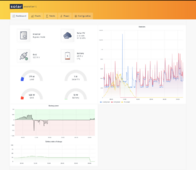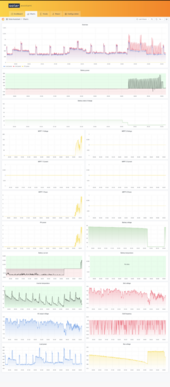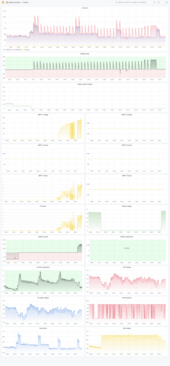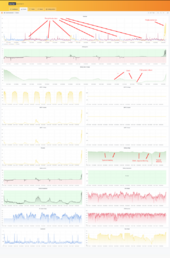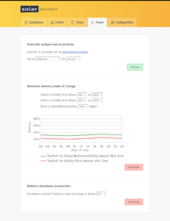Hi,
I've been using SPF 3000TL LVM-ES inverter for probably close to 3 years. I've had nothing but problems with it. For anyone who has this inverter, I would highly recommend not leaving it unattended. It has a tendency to randomly glitch in weird ways. The glitches don't appear to be an issue limited to my unit. I've heard of these problems from other owners. I've tried to work with Growatt to resolve my issues and they were responsive initially. However, it is clear that the firmware is a piece of crap. The hardware design is probably also garbage.
The first major problem was that it fried my appliances by sending too much voltage (300+V?) all the sudden randomly. This happened twice. I have two fried microwaves laying around to prove it. I had to install a voltage protection device to cut the output if it went out of expected range. Growatt did fix their firmware to prevent this and sent me update instructions. The overvoltage problem seemed to have been resolved by that. But, tell me, what kind of garbage hardware design allows software bugs to fry shit?
The other problem I've had is that it would randomly switch from 60hz to 50hz. Obviously, that also causes issues with my appliances. Other times I've noticed it would flip other settings randomly.
The inverter randomly freezes. Even the screen data is frozen in place. I believe when this happens the battery gets drained, even in full sunlight.
At some point, I set up solar assistant on a raspberry pi to get more visibility into what's going on.
USB communication board overheats in the summer and cuts out, so, I can't even get data from it during hot days. They need to install a heat sink on those chips.
The most recent issue is, it is trying to kill my batteries. I have no idea what happens, but the battery state of charge gets stuck at whatever point, meanwhile battery gets drained (rather quickly). My question would be, where is the energy going? It doesn't seem to be going into my appliances. This happens even in AC bypass mode. How can the battery be drained in AC bypass mode? I mean, there is some small "normal" drainage due to their stupid ass shitty design that drains the battery after it has been fully charged, even in full sunlight! However, this glitch is different. I have 10kwh battery bank that is at 24% when it switches to AC bypass. The usual small drainage (in AC bypass!) doesn't do much to the SOC. However during this particular glitch the battery gets drained to 0% SOC. During this glitch, some solar assistant graphs go out of whack, showing nonsensical values, such as battery being charged when it actually is getting drained. The BMS eventually disconnects the batteries and the inverter shows error code 19 (battery disconnect).
By the way, all these random glitches don't happen often, maybe once in a couple of months.
What an utter failure of a product.
I've been using SPF 3000TL LVM-ES inverter for probably close to 3 years. I've had nothing but problems with it. For anyone who has this inverter, I would highly recommend not leaving it unattended. It has a tendency to randomly glitch in weird ways. The glitches don't appear to be an issue limited to my unit. I've heard of these problems from other owners. I've tried to work with Growatt to resolve my issues and they were responsive initially. However, it is clear that the firmware is a piece of crap. The hardware design is probably also garbage.
The first major problem was that it fried my appliances by sending too much voltage (300+V?) all the sudden randomly. This happened twice. I have two fried microwaves laying around to prove it. I had to install a voltage protection device to cut the output if it went out of expected range. Growatt did fix their firmware to prevent this and sent me update instructions. The overvoltage problem seemed to have been resolved by that. But, tell me, what kind of garbage hardware design allows software bugs to fry shit?
The other problem I've had is that it would randomly switch from 60hz to 50hz. Obviously, that also causes issues with my appliances. Other times I've noticed it would flip other settings randomly.
The inverter randomly freezes. Even the screen data is frozen in place. I believe when this happens the battery gets drained, even in full sunlight.
At some point, I set up solar assistant on a raspberry pi to get more visibility into what's going on.
USB communication board overheats in the summer and cuts out, so, I can't even get data from it during hot days. They need to install a heat sink on those chips.
The most recent issue is, it is trying to kill my batteries. I have no idea what happens, but the battery state of charge gets stuck at whatever point, meanwhile battery gets drained (rather quickly). My question would be, where is the energy going? It doesn't seem to be going into my appliances. This happens even in AC bypass mode. How can the battery be drained in AC bypass mode? I mean, there is some small "normal" drainage due to their stupid ass shitty design that drains the battery after it has been fully charged, even in full sunlight! However, this glitch is different. I have 10kwh battery bank that is at 24% when it switches to AC bypass. The usual small drainage (in AC bypass!) doesn't do much to the SOC. However during this particular glitch the battery gets drained to 0% SOC. During this glitch, some solar assistant graphs go out of whack, showing nonsensical values, such as battery being charged when it actually is getting drained. The BMS eventually disconnects the batteries and the inverter shows error code 19 (battery disconnect).
By the way, all these random glitches don't happen often, maybe once in a couple of months.
What an utter failure of a product.
Attachments
Last edited:



